Optimization of the Fine to Coarse Aggregate Ratio for the Workability and Mechanical Properties of High Strength Steel Fiber Reinforced Concretes
Abstract
1. Introduction
2. Experimental Program
2.1. Materials
2.2. Mix Proportions and Sample Preparation
2.3. Testing Procedure
2.4. Prediction Models
3. Results and Discussion
3.1. Properties of Fresh Concrete
3.1.1. Influence of Steel Fibers on Slump of Concrete
3.1.2. Influence of Superplastizer on Concrete
3.2. Compressive Strength
3.3. Modulus of Elasticity
3.4. Load versus the Deflection
3.5. Predictive Relationships
4. Conclusions
- The addition of fiber contents greatly influences the workability of SFRC, and caused a reduction in slump. The material movement was reduced due to the addition of fibers, which act as a barrier to the movement of coarse aggregate.
- An increase in the FA/CA ratio affects the workability of SFRC, however, it does not have negative effect on its compressive strength.
- FA/CA ratio above 0.8 showed better flowability in the fresh state of SFRC, however, FA/CA ratio above 0.9 needed excessive superplasticizer to maintain flowability.
- Higher values of FA/CA ratio increased both compressive strength and flexural strength of SFRC, up to 10% and 28%, respectively.
- Steel fibers transferred the load to the concrete matrix by bridging the crack by means of bond stress, and continued to take load after the first crack or fracture of plain concrete.
- Experimental values of compressive strength and flexural strength showed good agreement with the available existing prediction equations, however, modulus of elasticity demonstrated slightly higher values.
- Experimentally obtained measurements enabled the establishment of isoresponse interactive equations and contours, which have prediction capabilities within the scope of the investigation domain.
- FA and CA contribute up to 75% of total concrete volume, therefore, balancing the usage of FA and CA plays a vital role in determining the performance and quality of the concrete.
Author Contributions
Funding
Acknowledgments
Conflicts of Interest
References
- Sung-Hoon, K.; Sung-Gul, H.; Moon, J. Performance comparison between densified and undensified silica fume in ultra-high performance fiber-reinforced concrete. Materials 2020, 13, 3901. [Google Scholar] [CrossRef]
- Grünewald, S.; Walraven, J.C. Parameter—Study on the influence of steel fibers and coarse aggregate content on the fresh properties of self—Compacting concrete. Cem. Concr. Res. 2001, 31, 1793–1798. [Google Scholar] [CrossRef]
- Sahmaran, M.; Christianto, H.A.; Yaman, I.O. The effect of chemical admixtures and mineral additives on the properties of self-compacting mortars. Cem. Concr. Res. 2006, 28, 432–440. [Google Scholar] [CrossRef]
- Benabed, B.; Kadri, E.; Azzouz, L.; Kenai, S. Properties of self-compacting mortar made with various types of sand. Cem. Concr. Res. 2012, 34, 1167–1173. [Google Scholar] [CrossRef]
- Boulekbache, B.; Hamrat, M.; Chemrouk, M.; Amziane, S. Flowability of fiber-reinforced concrete and its effect on the mechanical properties of the material. Constr. Build. Mater. 2010, 24, 1664–1671. [Google Scholar] [CrossRef]
- Khayat, K.H. Workability, testing and performance of self-compacting concrete. ACI Mater. J. 1999, 96, 346–353. [Google Scholar]
- El-Dieb, A.S.; Taha, M.M.R. Flow characteristics and acceptance criteria of fiber-reinforced self-compacted concrete (FR-SCC). Constr. Build. Mater. 2012, 27, 585–596. [Google Scholar] [CrossRef]
- Khayat, K.H.; Roussel, Y. Testing and performance of fiber-reinforced, self-consolidating concrete. Mater. Struct. Matér. Constr. 2000, 33, 391–397. [Google Scholar] [CrossRef]
- Mostafa, S.A.; Faried, A.S.; Farghali, A.A.; EL-Deeb, M.M.; Tawfik, T.A.; Majer, S.; Elrahman, M.A. Influence of nanoparticles from waste materials on mechanical properties, durability and microstructure of UHPC. Materials 2020, 13, 4530. [Google Scholar] [CrossRef]
- Siwiński, J.; Szcześniak, A.; Stolarski, A. Modified formula for designing ultra-high-performance concrete with experimental verification. Materials 2020, 13, 4518. [Google Scholar] [CrossRef]
- Ulas, M.A.; Alyamaç, K.E.; Ulucan, Z.C. Assessment of the Behavior of Steel-Fiber Reinforced Concrete Produced with Different Ratios of Fine-to-Coarse Aggregate. In Proceedings of the 4th International Conference on Sustainable Construction Materials and Technologies, Las Vegas, NV, USA, 7–11 August 2016; Available online: http://www.claisse.info/2016%20papers/S130.pdf (accessed on 14 August 2020).
- ACI Committee 544.1R. State-of-the-Art Report on Fiber Reinforced Concrete; American Concrete Institute: Farmington Hills, MI, USA, 2005; Available online: http://indiafiber.com/Files/ACI%20report.pdf (accessed on 8 July 2020).
- Banthia, N.; Sappakittipakorn, M. Toughness enhancement in steel fiber reinforced concrete through fiber hybridization. Cem. Concr. Res. 2007, 37, 1366–1372. [Google Scholar] [CrossRef]
- Tadepalli, P.R.; Mo, Y.L.; Hsu, T.T.C. Mechanical properties of steel fibre concrete. Mag. Concr. Res. 2013, 65, 462–474. [Google Scholar] [CrossRef]
- Banthia, N. A study of some factors affecting the fiber–matrix bond in steel fiber reinforced concrete. Can. J. Civ. Eng. 1990, 17, 610–620. [Google Scholar] [CrossRef]
- Chenkui, H.; Guofan, Z. Properties of Steel Fibre Reinforced ConcretebContaining Larger Coarse Aggregate. Cem. Concr. Compos. 1995, 17, 199–206. [Google Scholar] [CrossRef]
- Kim, J.J.; Kim, D.J.; Kang, S.T.; Lee, J.H. Influence of sand to coarse aggregate ratio on the interfacial bond strength of steel fibers in concrete for nuclear power plant. Nucl. Eng. Des. 2012, 252, 1–10. [Google Scholar] [CrossRef]
- ACI 318-19. Building Code Requirements for Structural Concrete and Commentary; American Concrete Institute: Farmington Hills, MI, USA, 2019; Available online: https://concrete.org/topicsInConcrete/topicdetail/318%20Building%20Code?search=318%20Building%20Code (accessed on 27 September 2019).
- Fantilli, A.P.; Cavallo, A.D.; Pistone, G. Fiber-reinforced lightweight concrete slabs for the maintenance of the Soleri Viaduct. Eng. Struct. 2015, 99, 184–191. [Google Scholar] [CrossRef]
- Lee, S.-J.; Yoo, D.-Y.; Moon, D.-Y.K.; Sung-Gul, H.; Moon, J. Effects of Hooked-End Steel Fiber Geometry and Volume Fraction on the Flexural Behavior of Concrete Pedestrian Decks. Appl. Sci. 2019, 9, 1241. [Google Scholar] [CrossRef]
- Neves, R.D.; de Almeida, J.C.O.F. Compressive behaviour of steel fibre reinforced concrete. Struct. Concr. 2005, 6, 1–8. [Google Scholar] [CrossRef]
- Abbass, W.; Khan, M.I.; Murad, S. Evaluation of mechanical properties of steel fiber reinforced concrete with different strengths of concrete. Constr. Build. Mater. 2018, 168, 556–569. [Google Scholar] [CrossRef]
- ACI 544.3R-08. Guide for Specifying, Proportioning, and Production of Fiber-Reinforced Concrete; American Concrete Institute: Farmington Hills, MI, USA, 2008; Available online: https://www.concrete.org/store/productdetail.aspx?ItemID=544308&Format=DOWNLOAD&Language=English&Units=US_AND_METRIC (accessed on 6 September 2019).
- ASTM C150M-20. Standard Specification for Portland Cement. American Society for Testing and Materials; American Concrete Institute: Farmington Hills, MI, USA, 2020; Available online: https://www.astm.org/Standards/C150 (accessed on 6 September 2019).
- ASTM C494M-19. Standard Specification for Chemical Admixtures for Concrete. American Society for Testing and Materials; American Concrete Institute: Farmington Hills, MI, USA, 2019; Available online: https://www.astm.org/Standards/C494 (accessed on 6 September 2019).
- ASTM C33M-18. Standard Specification for Concrete Aggregates. American Society for Testing and Materials; American Concrete Institute: Farmington Hills, MI, USA, 2018; Available online: https://www.astm.org/Standards/C33 (accessed on 6 September 2019).
- ASTM C31M-19a. Standard Practice for Making and Curing Concrete Test Specimens in the Field. American Society for Testing and Materials; American Concrete Institute: Farmington Hills, MI, USA, 2019; Available online: https://www.astm.org/Standards/C31 (accessed on 6 September 2019).
- ASTM C469M-18. Standard Test Method for Static Modulus of Elasticity and Poisson’s Ratio of Concrete in Compression. American Society for Testing and Materials; American Concrete Institute: Farmington Hills, MI, USA, 2018; Available online: https://www.astm.org/Standards/C469 (accessed on 6 September 2019).
- Ryan, B.F.; Joiner, B.L.; Cryer, J.D. Minitab Handbook, Release 16, 6th ed.; Cengage Learning: Boston, MA, USA, 2012. [Google Scholar]
- Neville, A.M. Properties of Concrete, 3th ed.; Pitman: London, UK, 1995. [Google Scholar]
- ACI Committee 363R-97. State-of-the-Art Report on High Strength Concrete; American Concrete Institute: Farmington Hills, MI, USA, 1997; Available online: https://www.concrete.org/publications/internationalconcreteabstractsportal/m/details/id/10692 (accessed on 7 November 2019).
- CEB-FIP Model Code for Concrete Structures. Evaluation of the Time Dependent Behavior of Concrete; Bulletin information No. 199; Comite Europe du Beton/Federation Internationale de Precontrainte: Lausanne, Switzerland, 1991; Available online: https://www.fib-international.org/publications/ceb-bulletins/evaluation-of-the-time-dependent-behavior-of-concrete-pdf-detail.html (accessed on 7 November 2019).
- Ahmad, S.H.; Shah, S.P. Structural properties of high strength concrete and its applications for precast prestressed concrete. PCI J. 1985, 30, 97–123. [Google Scholar]
- Jo, B.-W.; Shon, Y.-H.; Kim, Y.-J. The Evalution of Elastic Modulus for Steel Fiber Reinforced Concrete. Russ. J. Nondestruct. Test. 2001, 37, 152–161. [Google Scholar] [CrossRef]
- Xu, B.W.; Shi, H.S. Correlations among mechanical properties of steel fiber reinforced concrete. Constr. Build. Mater. 2009, 23, 3468–3474. [Google Scholar] [CrossRef]
- Perumal, R. Correlation of Compressive Strength and Other Engineering Properties of High-Performance Steel Fiber–Reinforced Concrete. J. Mater. Civ. Eng. 2015, 27, 1–8. [Google Scholar] [CrossRef]


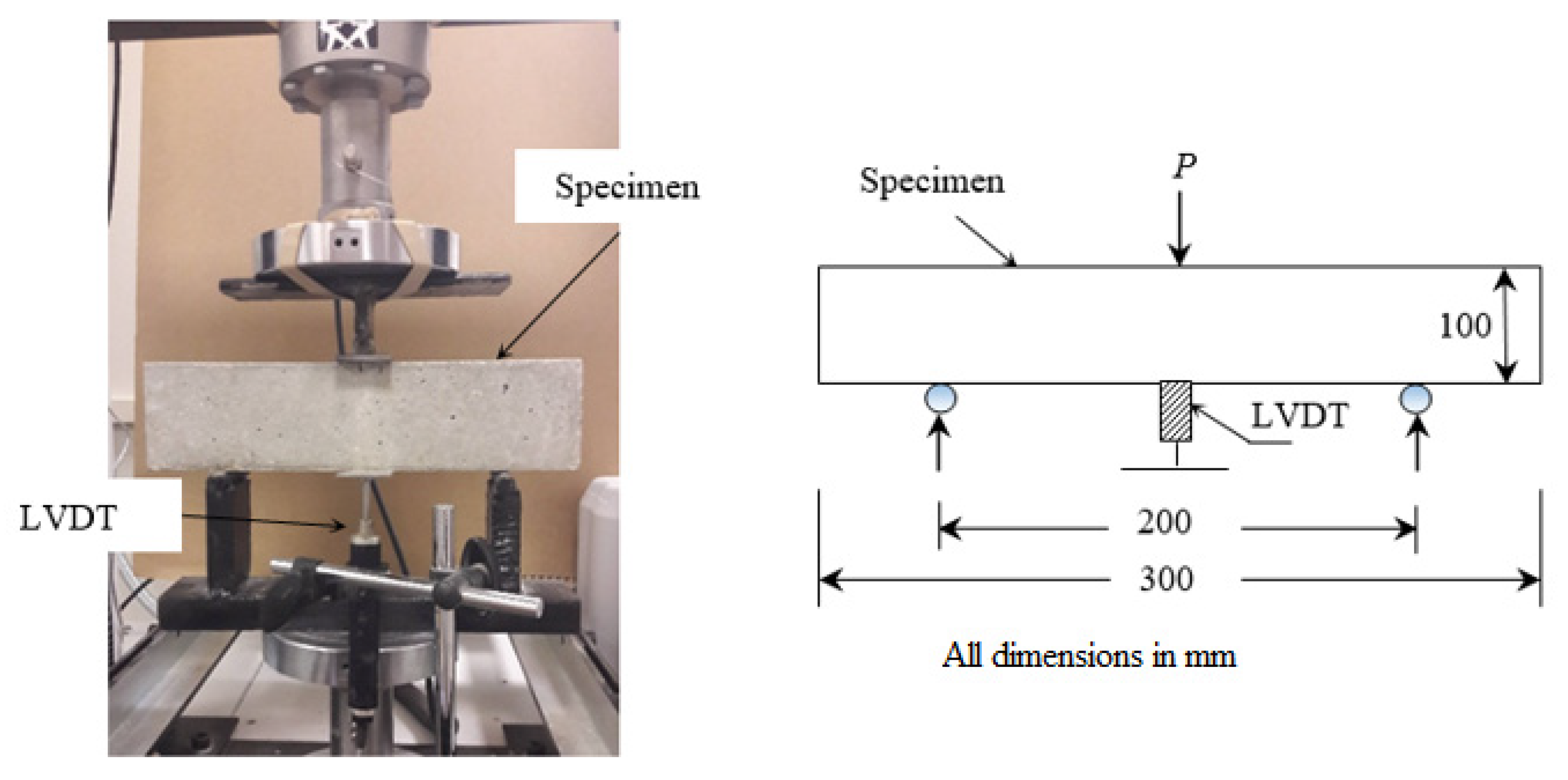
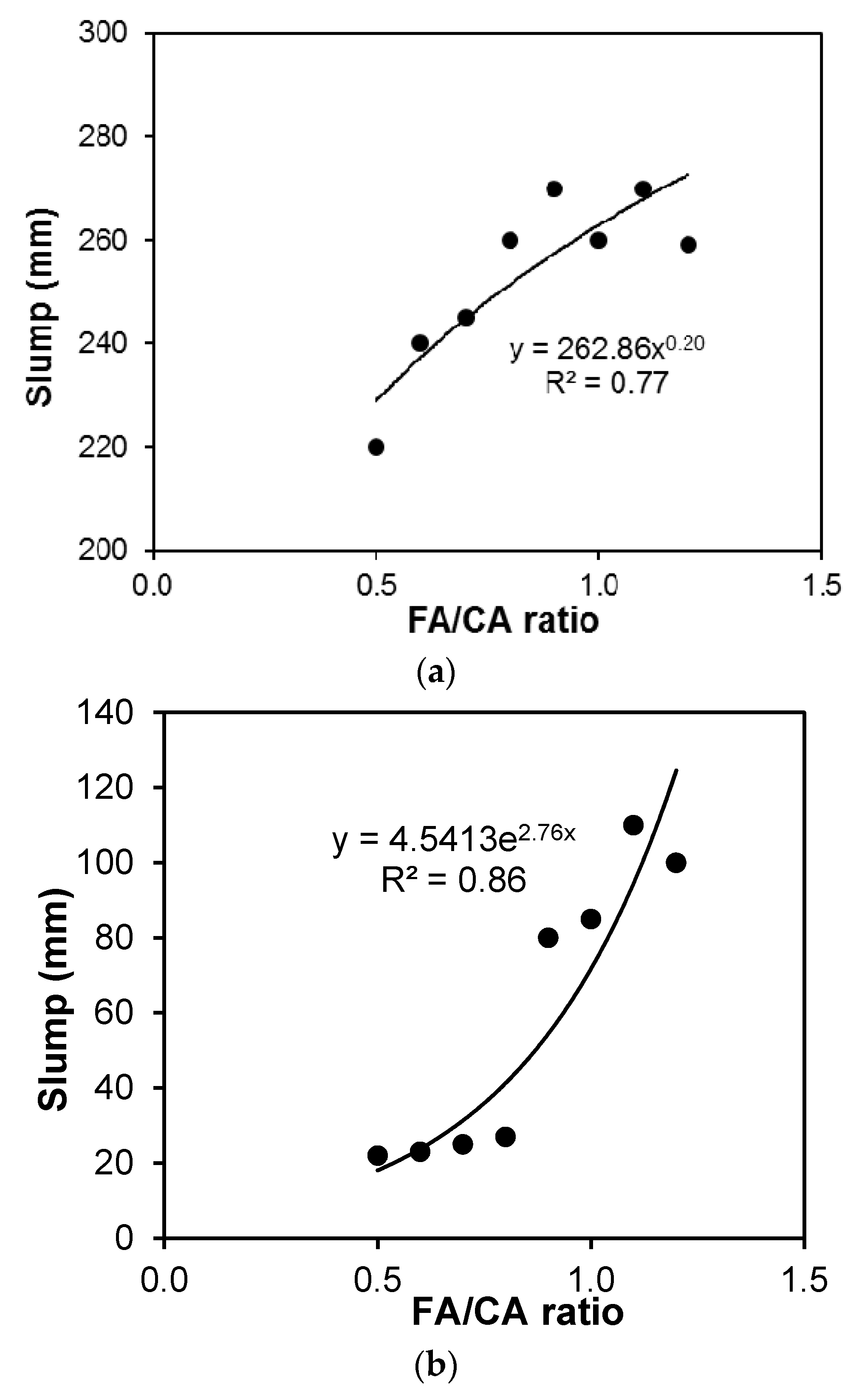
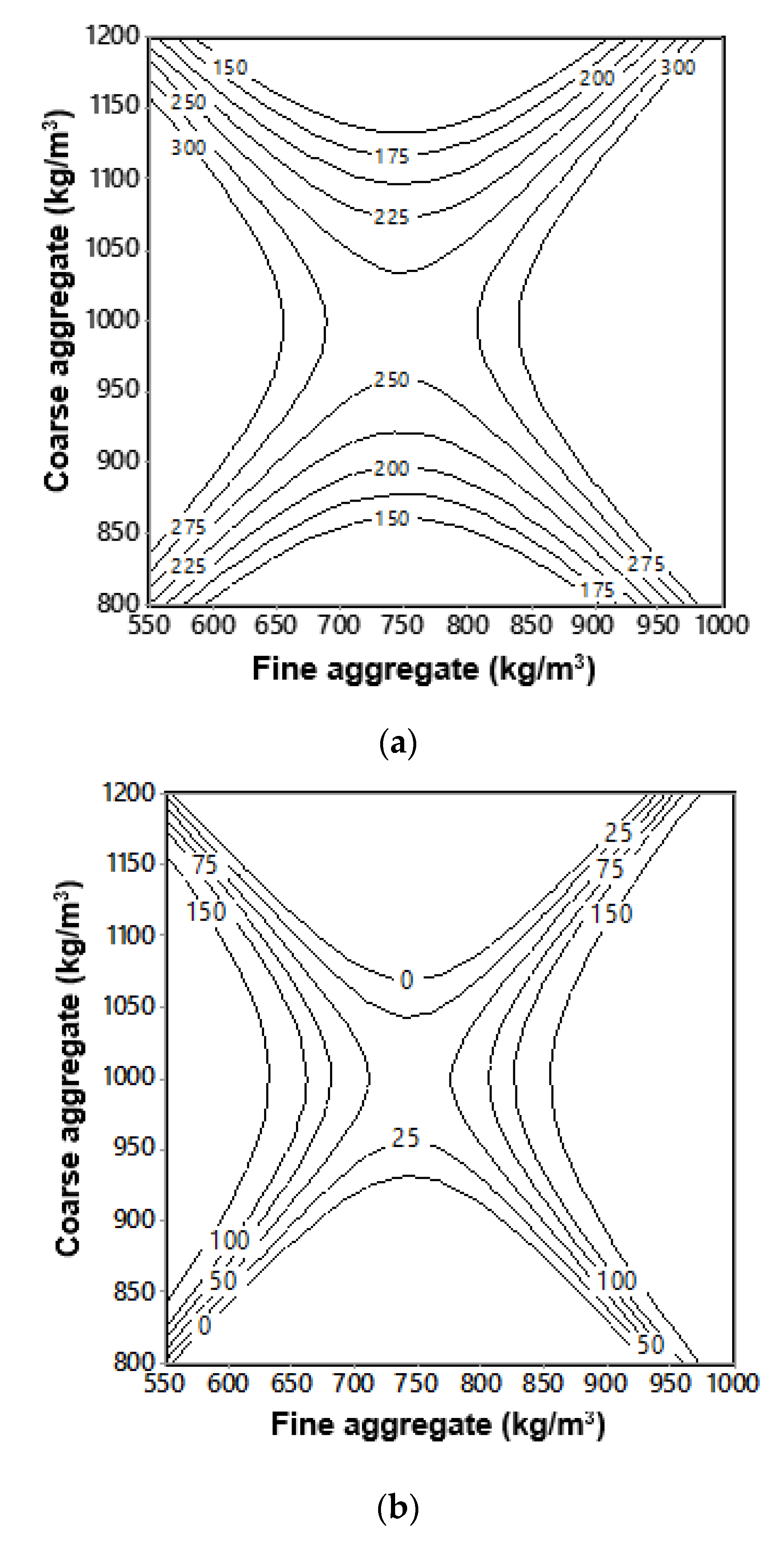
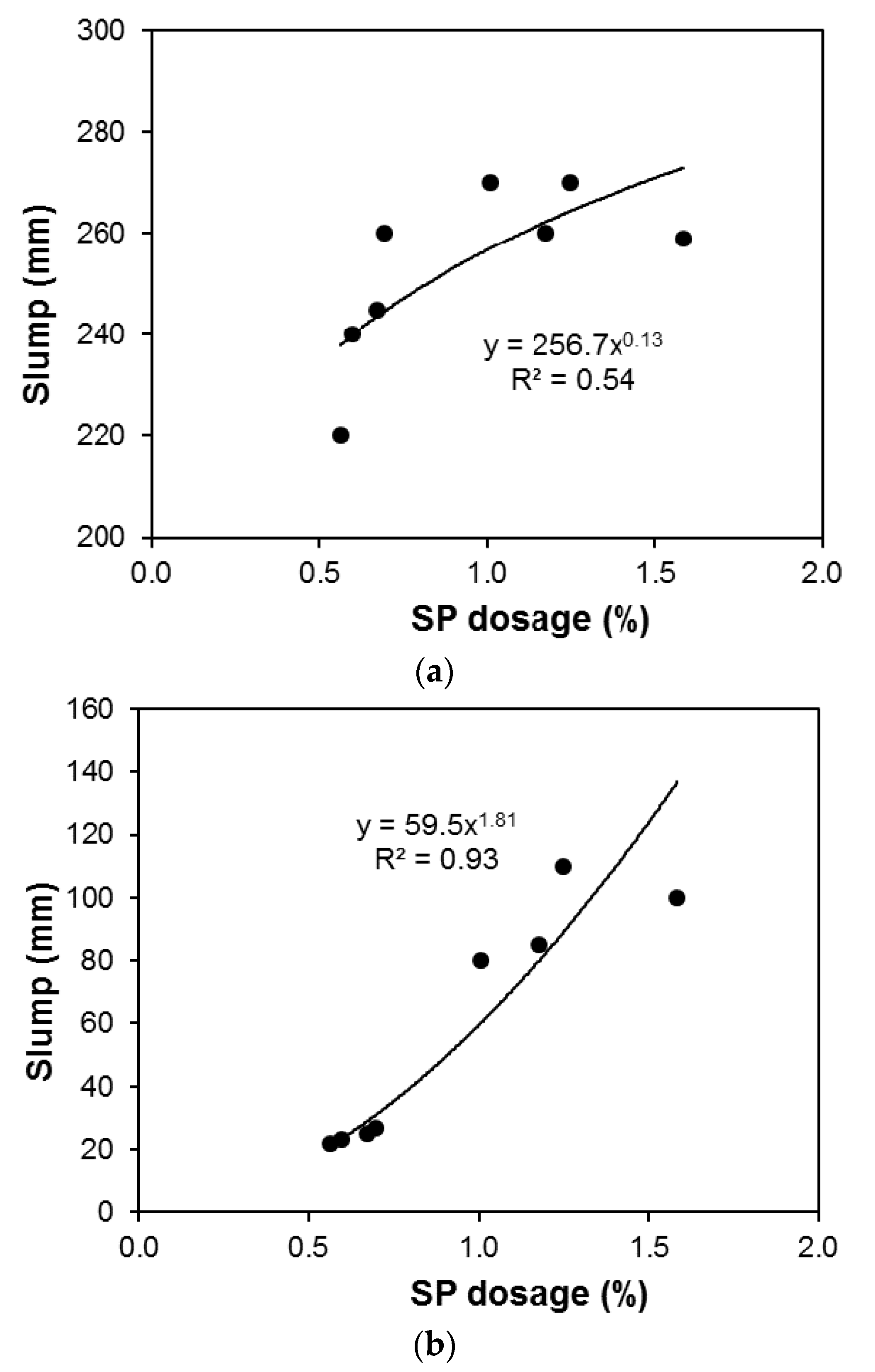


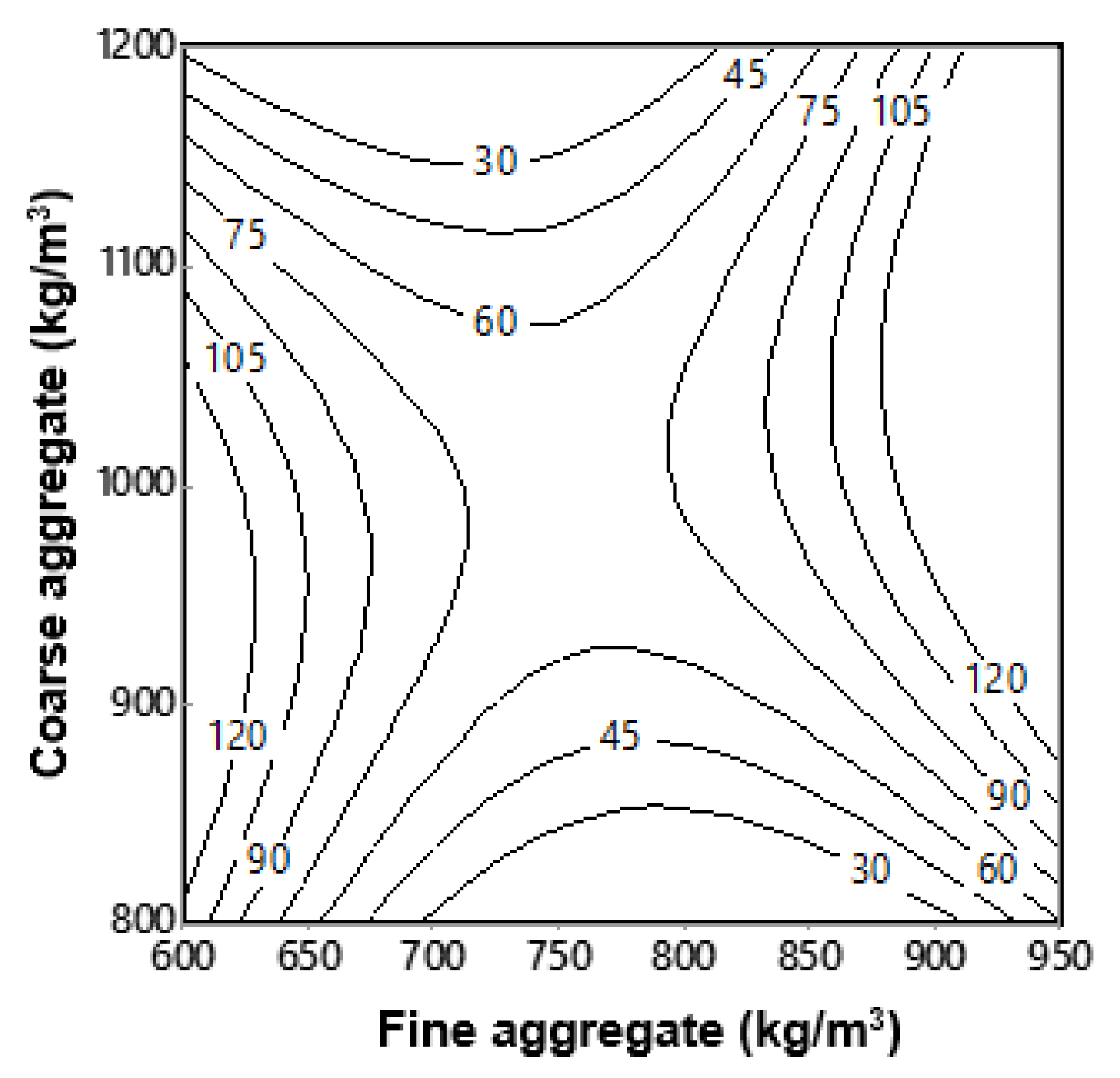
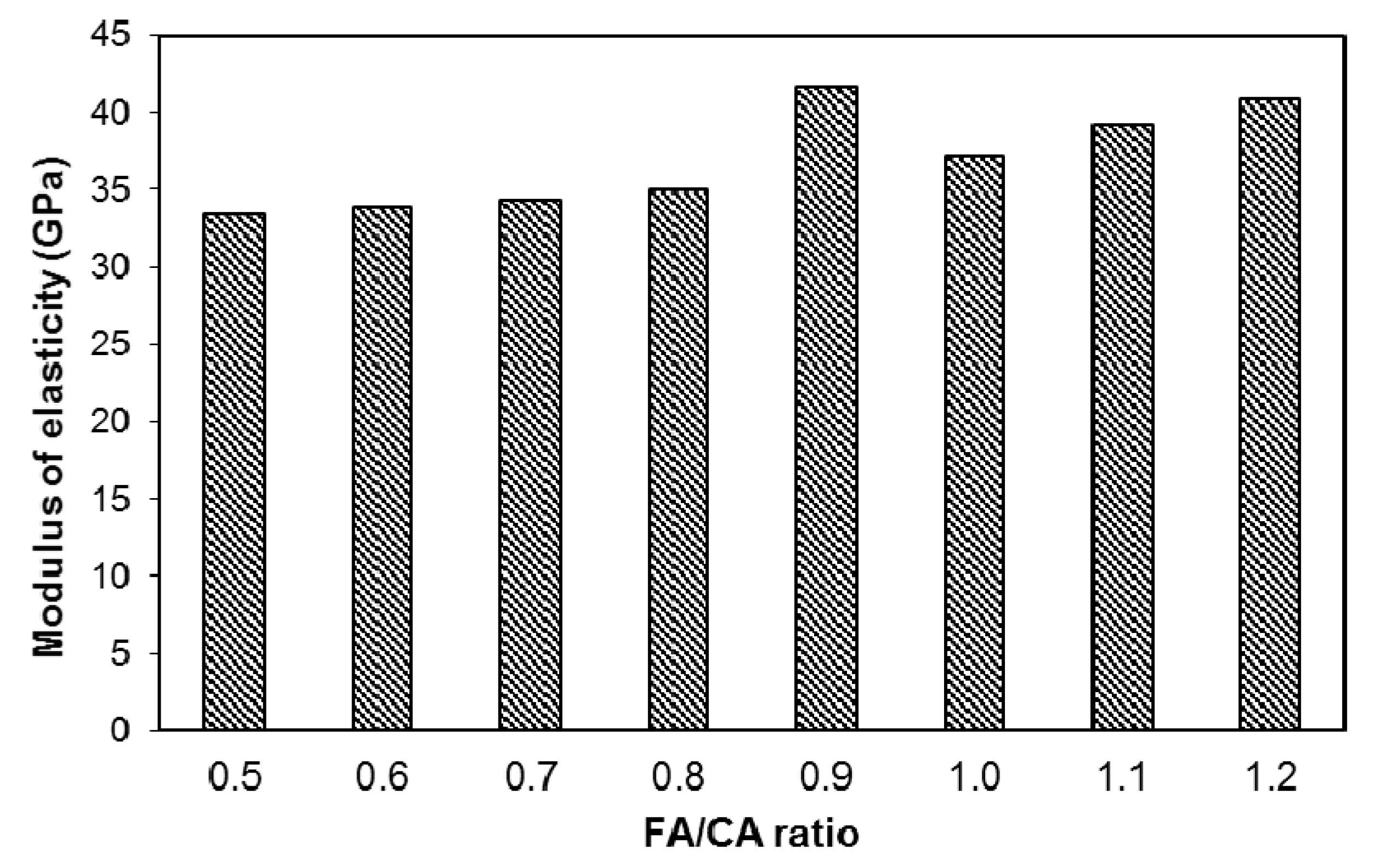
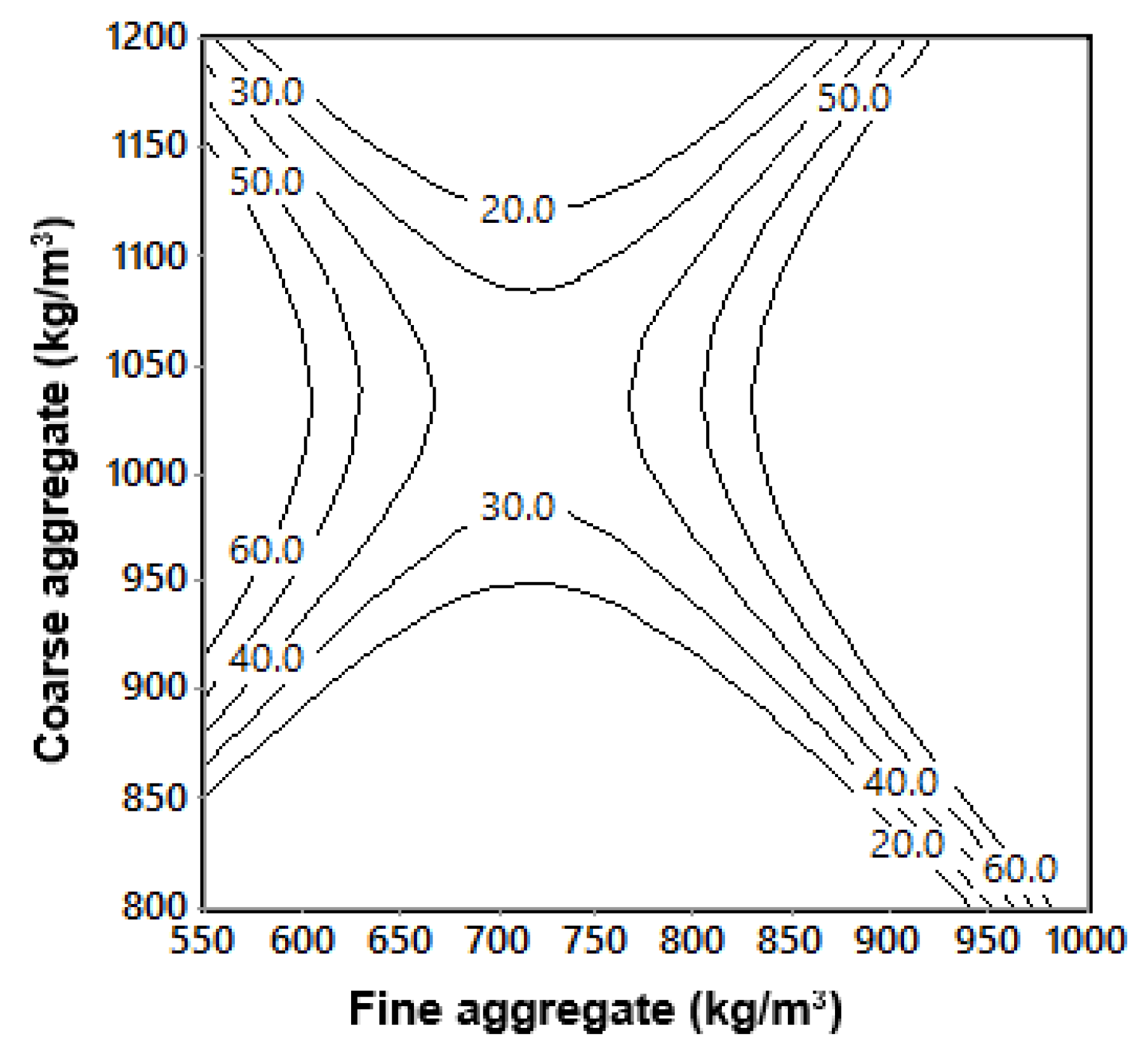


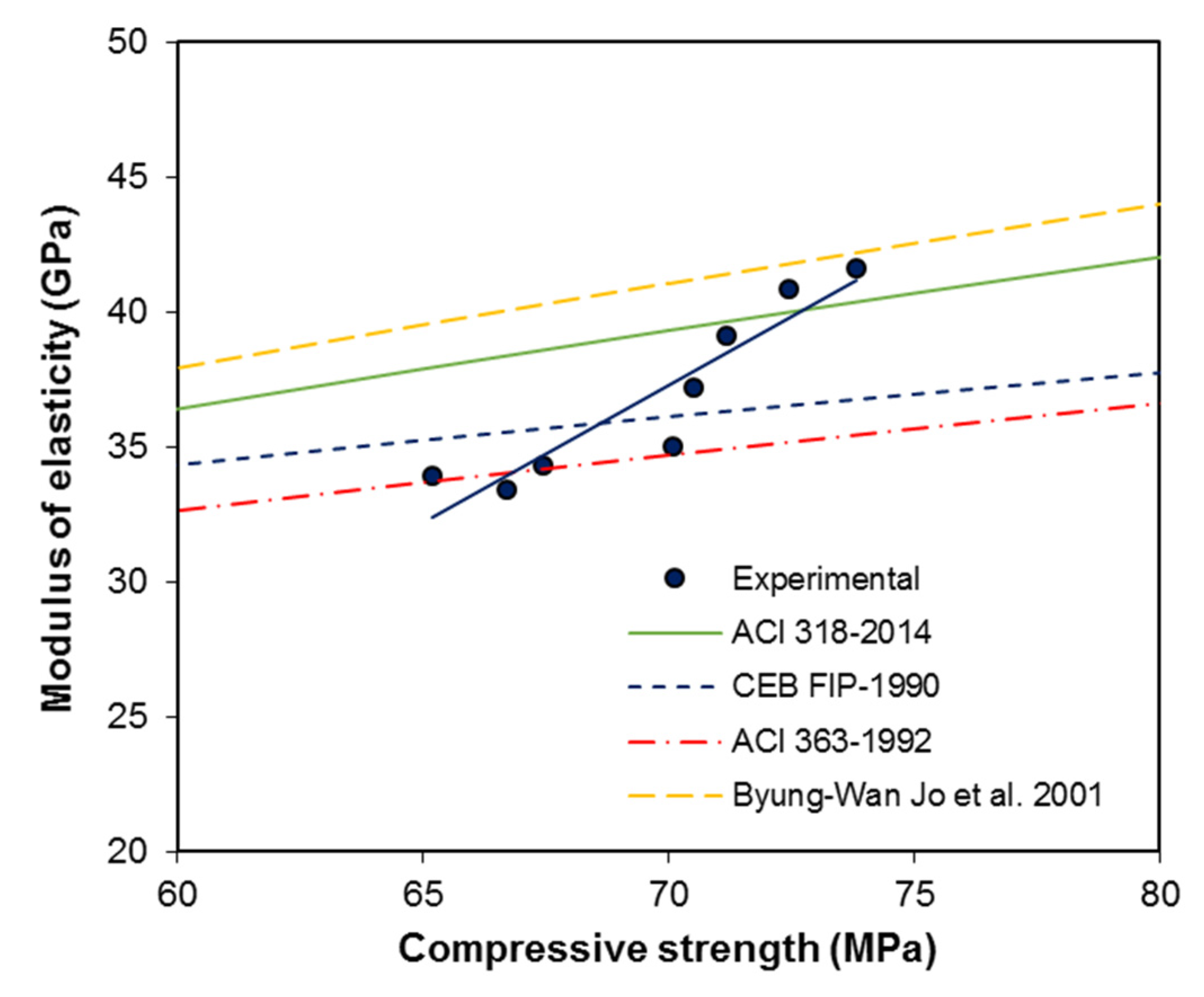
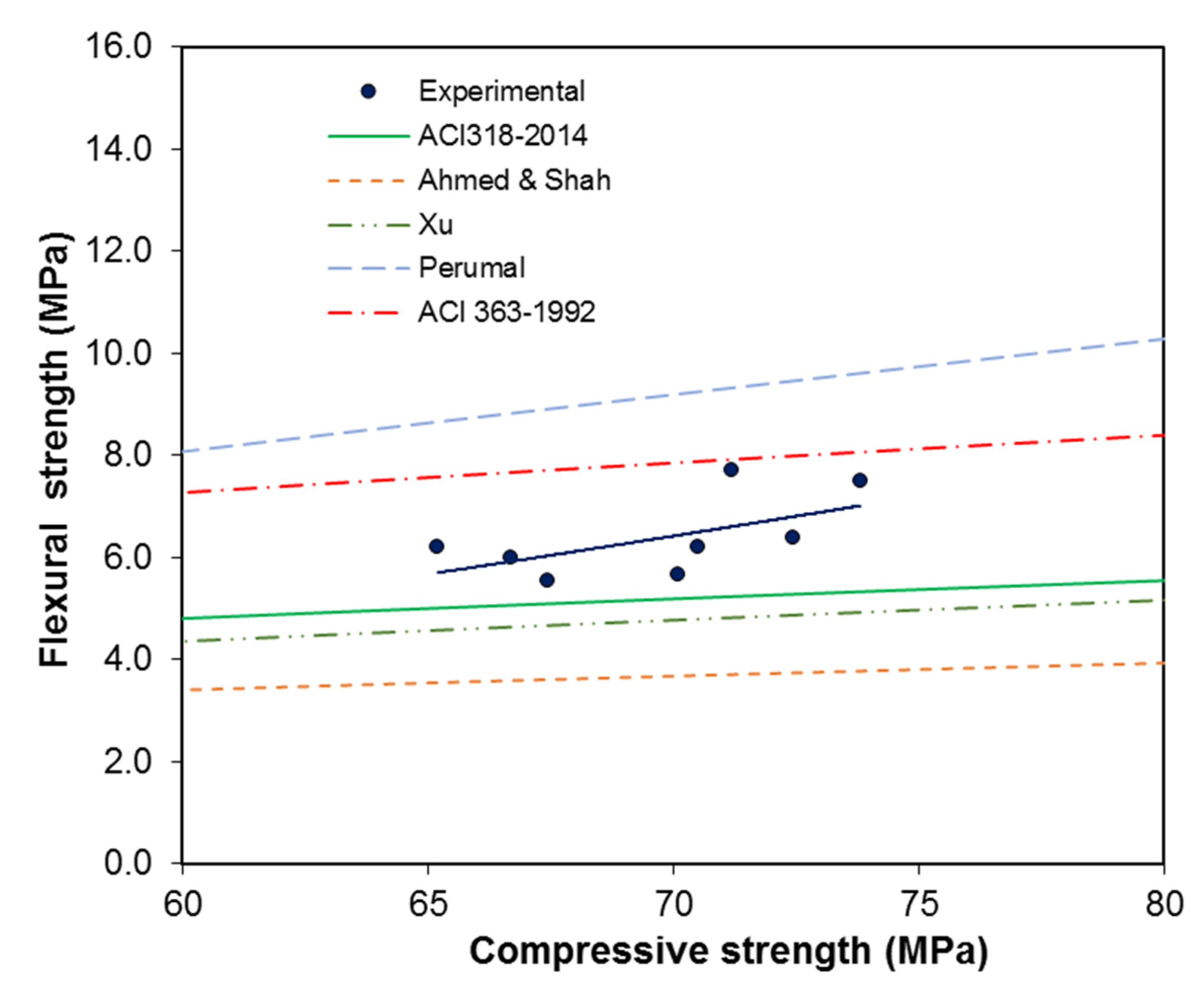

| Elemental Oxide (%) | Loss on Ignition (%) | Specific Gravity | Fineness (m2/kg) | ||||||
|---|---|---|---|---|---|---|---|---|---|
| SiO2 | Al2O3 | Fe2O3 | CaO | MgO | SO3 | Na2O | |||
| 20.2 | 5.49 | 4.12 | 65.43 | 0.71 | 2.61 | 0.26 | 1.38 | 3.14 | 373 |
| Aspect Ratio | Length (mm) | Diameter (µm) | Tensile Strength (MPa) | Young’s Modulus (GPa) |
|---|---|---|---|---|
| 80 | 60 | 750 | 1250 | 210 |
| Specimen ID | FA/CA Ratio | Fine Aggregate (kg/m3) | Coarse Aggregate (kg/m3) | Water (kg/m3) | SP 1 (mL) |
|---|---|---|---|---|---|
| M50 | 0.5 | 580 | 1170 | 171.19 | 117 |
| M60 | 0.6 | 660 | 1100 | 170.70 | 124 |
| M70 | 0.7 | 730 | 1040 | 170.44 | 140 |
| M80 | 0.8 | 560 | 980 | 170.0 | 120 |
| M90 | 0.9 | 835 | 930 | 169.70 | 210 |
| M100 | 1.0 | 880 | 880 | 169.37 | 245 |
| M110 | 1.1 | 925 | 840 | 169.14 | 260 |
| M120 | 1.2 | 965 | 800 | 168.88 | 330 |
| Specimen ID | Fresh Properties | |||
|---|---|---|---|---|
| Slump 1 (mm) | Slump 2 (mm) | Temperature (°C) | Unit Weight (kg/m3) | |
| M50 | 220 | 22 | 23.9 | 2306 |
| M60 | 240 | 23 | 23 | 2403 |
| M70 | 245 | 25 | 23.2 | 2343 |
| M80 | 260 | 27 | 23.3 | 2356 |
| M90 | 280 | 80 | 21.7 | 2276 |
| M100 | 260 | 85 | 22.3 | 2260 |
| M110 | 270 | 110 | 23.7 | 2266 |
| M120 | 240 | 100 | 21.8 | 2353 |
Publisher’s Note: MDPI stays neutral with regard to jurisdictional claims in published maps and institutional affiliations. |
© 2020 by the authors. Licensee MDPI, Basel, Switzerland. This article is an open access article distributed under the terms and conditions of the Creative Commons Attribution (CC BY) license (http://creativecommons.org/licenses/by/4.0/).
Share and Cite
Iqbal Khan, M.; Abbass, W.; Alrubaidi, M.; Alqahtani, F.K. Optimization of the Fine to Coarse Aggregate Ratio for the Workability and Mechanical Properties of High Strength Steel Fiber Reinforced Concretes. Materials 2020, 13, 5202. https://doi.org/10.3390/ma13225202
Iqbal Khan M, Abbass W, Alrubaidi M, Alqahtani FK. Optimization of the Fine to Coarse Aggregate Ratio for the Workability and Mechanical Properties of High Strength Steel Fiber Reinforced Concretes. Materials. 2020; 13(22):5202. https://doi.org/10.3390/ma13225202
Chicago/Turabian StyleIqbal Khan, Mohammad, Wasim Abbass, Mohammad Alrubaidi, and Fahad K. Alqahtani. 2020. "Optimization of the Fine to Coarse Aggregate Ratio for the Workability and Mechanical Properties of High Strength Steel Fiber Reinforced Concretes" Materials 13, no. 22: 5202. https://doi.org/10.3390/ma13225202
APA StyleIqbal Khan, M., Abbass, W., Alrubaidi, M., & Alqahtani, F. K. (2020). Optimization of the Fine to Coarse Aggregate Ratio for the Workability and Mechanical Properties of High Strength Steel Fiber Reinforced Concretes. Materials, 13(22), 5202. https://doi.org/10.3390/ma13225202






